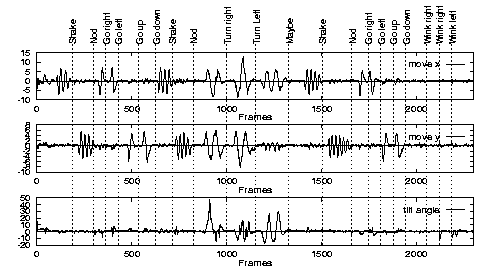



Facial Motion Gesture Recognition
Robust real-time face tracking gives rise to the possibility of
recognising gestures based on motions of the head.
Gesture recognition and face tracking are implemented as
independent processes.
Both processes run at the NTSC video frame rate (30Hz).
The design of the algorithms for gesture recognition is determined
by hard real-time constraints since a dozen of gestures must be
compared with the data stream from the face tracking module.
Also, gesture recognition must be flexible in respect to the
performance of the gesture including timing and amplitudes of the
parameter.
The system should assign confidence values to the gestures that it
recognises.
This allows higher level processes to use the gestures as input and
interpret them optimally.
To avoid the computationally expensive time warping method we
developed a recursive method taking only the current motion vector of
the face into account.
A set of finite state machines implicitly store the previous tracking
information.
Gesture recognition is implemented as a two layer system based on
the decomposition of gestures into atomic actions.
The lower layer recognises basic motion primitives and state
primitives called atomic actions.
The output of an atomic action consists of its activation which is a
measure for the similarity of the recent motion vectors and the atomic
action definition.
The system incorporates 22 predefined atomic actions for which the
activation is calculated in each frame cycle.
The upper layer is concerned with the recognition of patterns in the
activation of the set of atomic actions.
A gesture is defined by a sequence of atomic actions and time
constraints for the occurrence of each of them.
Each time the first atomic action of a gesture definition is activated
an instance of a finite state machine is generated dynamically.
This instance then observes the activation of the next atomic action
in the gesture definition and does the transition to the next state if
the activation occurs within a given time frame.
If no activation occurs in the time frame the finite state machine
instance is deleted from the system.
When the state machine reaches it's final state the atomic action
sequence is completely recognised and the gesture is send to output
together with a confidence measure of how well the observed pattern
matched the gesture definition.
The figure shows the result of a gesture recognition test sequence.





Feedback & Queries: Jochen Heinzmann
Date Last Modified: Thursday, 24th Oct 1997












